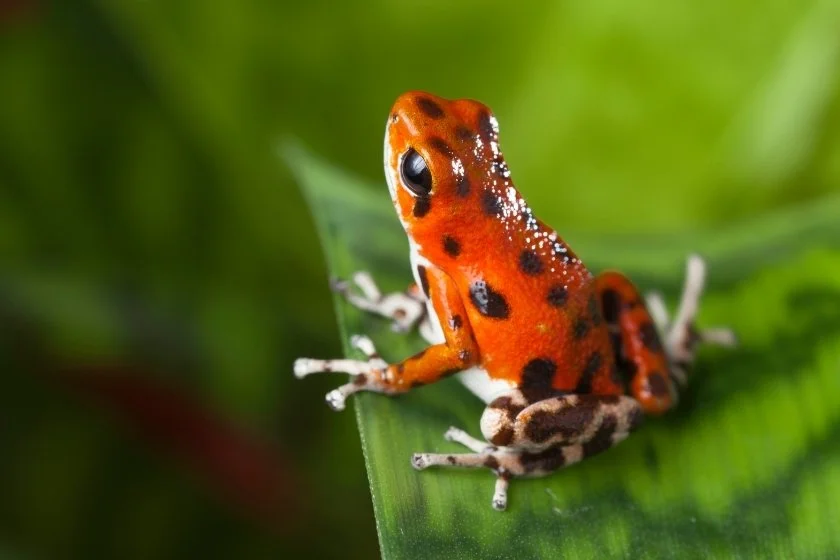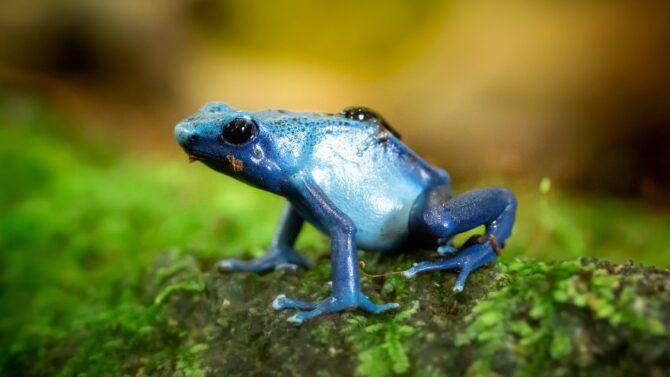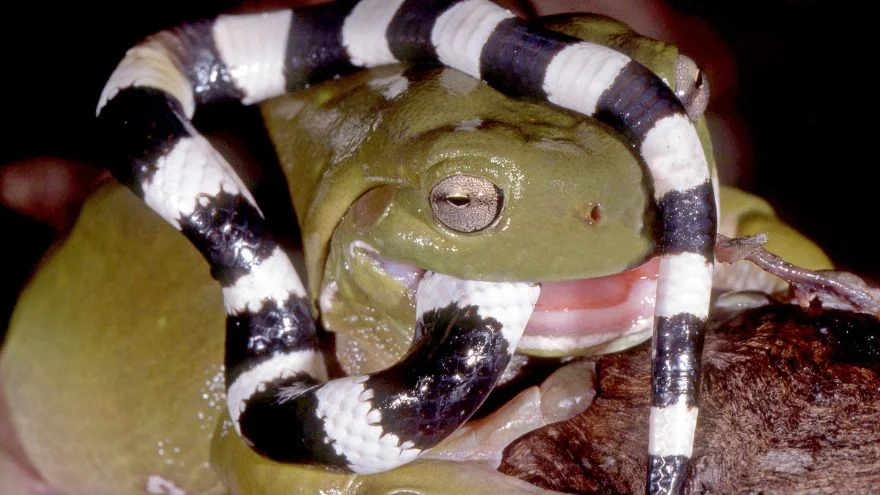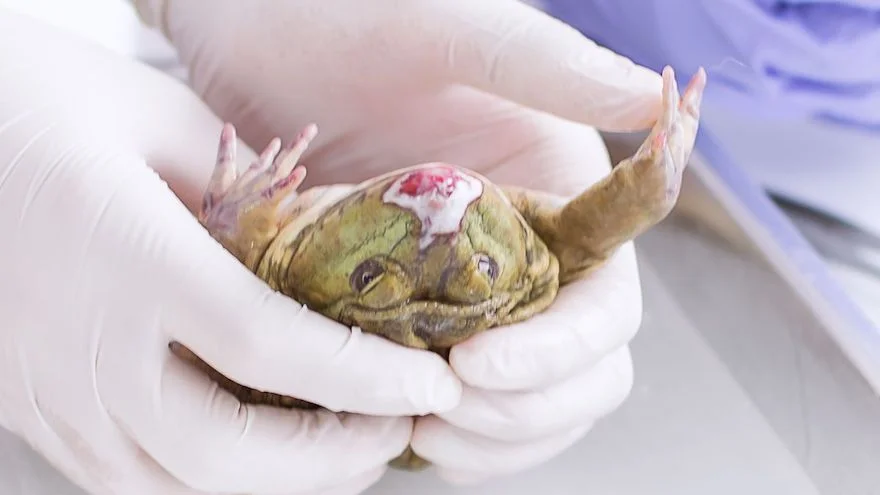It is believed that dart frogs synthesize toxins from their diet. But what do poison dart frogs eat that makes their skin so toxic? Read on to discover the complete diet facts in the wild and in captivity.
Known by many names including poison frogs or arrow frogs, poison dart frogs are undoubtedly one of the world’s most beautiful animals.
The name dart frog came from an ancient time when native Americans used poison collected from these frogs to make the tip of blow darts deadly.
There are over 170 dart frog species, each with distinctive bright skin color. This color of the skin is very attractive.
However, It is also a sign for predators not to come too close. While many people are aware of the poisonous nature of the dart frog, you will still find dart frogs in some homes as pets.
Let us see what exactly the diet of a dart frog looks like
What Do Poison Dart Frogs Eat?

Poison dart frogs eat just about anything on the menu, similar to other frog species. There are some factors to consider, though, including the size and quantity of food.
Dart frogs eat ants, termites, and other small insects in the wild, which explains why they have toxic skins.
Scientists believe that certain plants contain chemicals known as alkaloids. These chemicals act as defensive measures that protect them from being eaten by herbivores and insects.
These chemicals also affect human beings in different ways. However, some insects have found ways of eating these plants regardless.
Poison dart frogs, in turn, feed on these insects that must have eaten these plants and convert these chemicals into their defense mechanism.
To further prove this, it has been discovered that dart frogs raised in captivity do not have toxic skin. 1
Here is a complete list of poison dart frog diets:
- Ants
- Termites
- Worms
- Bean beetles
- Alkaloid-rich arthropod
- Crickets
- Fruit flies (In the wild and in captivity)
Ants
Ants are very small and easy picks for the dart frog and other ant predators. Since the dart frog does not eat much because of its size, a few ants daily would make a nutritious part of its meal.
Like every other species, the dart frog has a sticky tongue to catch these small insects.
Fruit Flies
Another preference of the dart frogs is fruit flies in the wild or in your home as pets.
Fruit flies are very common, especially in fruits and perishable vegetables like tomatoes and grapes. 2
Fruit flies are attracted to fruits, making them an easy meal for dart frogs in the wild, and especially for people who keep dart frogs as pets.
If you keep dart frogs as pets, you can easily trap your fruit flies and feed them to your frogs, or you could culture the flies so that you have a steady inflow of fruit flies for your pet.
Crickets
Crickets are also a very good option when feeding your frogs, but as said earlier, dart frogs are limited by size, so they cannot eat adult crickets.
However, they can feed on pinhead crickets. 1 to 3 days old crickets are pretty small, reaching about 1/8 of an inch in size, which makes them easy for the small-size dart frog to eat.
Crickets are not easy to raise or keep, like fruit flies, but if you wish to give your dart frogs a nutritious meal, you might want to consider crickets.
You would have to gut-load them first, though. This means feeding the crickets nutritious food two days before you feed them to your frogs.
Termites
Termites live in the soil—in decomposing plants, specifically—and feed on wood as a decomposing matter.
Essentially, termites are decomposers known for destroying furniture and parts of the house made of wood. However, this pest is also a high source of protein for your pet frogs.
Termites are rich in proteins and vitamins and carry a very little anti-nutrient.
They also feed on various plants as a decomposing matter which would explain why dart frogs feed on them. Termites should be on your dart frog’s menu if you have one as a pet.
Worms
Dart frogs eat several worms ranging from earthworms to blood worms. Any living worm within the frog’s range is a meal to them.
However, it is important to know one thing about dart frogs, whether in the wild or in captivity; they are predators, and they will not go after dead worms.
Frogs react to movement, so a dead worm will never attract a dart frog.
Poison dart frogs are also very small, so there is a size of worm that they can eat.
Generally, the rule is that the circumference of the worm should be shorter than the distance between the frog’s eyes.
The length of the frog shouldn’t be less than 3 times the length of the worm to be fed to it; else, cut the worm in half.
Bean Beetles
Bean beetles, also known as bean weevils or cowpea weevils, are arthropods that attack cowpea seeds.
They are small, winged insects that can serve as food for dart frogs. Though dart frogs in the wild may not have much access to feeding on bean beetles, it is a very easy option for pet owners.
Bean beetles live in the cowpea seed and multiply rapidly. Gut loading is also not a problem since they live in the bean seed they eat.
Bean beetles feed on cowpea seeds and reproduce in the seeds. They also eat so much of the beans seed that you don’t need to load them with nutrients before they are fed to your frogs.
Alkaloid Rich Arthropods
As mentioned above, some insects can consume plants with defensive chemicals known as alkaloids.
It is believed that dart frogs get some of their toxins from eating some of these arthropods and converting their alkaloids into toxins that they use to protect themselves from predators.
How Do Dart Frogs Hunt?
Like any other frog species, poison dart frogs hunt prey with their tongue.
They have a retractable tongue that is used for hunting. The tongue is covered in mucus which makes it very sticky.
The tongue is also a third of the frog’s body length. When hunting, the frog propels the tongue at the prey, and the sticky mucus ends if the tongue catches the prey, which is quickly retracted back to the mouth of the frog.
It is important to know that these frogs are predators and hunt their prey live. A poison dart frog will not eat a dead bug or insect except it is starving, which is very rare for a frog in the wild.
Do Dart Frogs Poison Their Prey?
The toxicity of the dart frog’s skin is more of a defensive or protective measure rather than a means to catch and hold on to prey.
The dart frog’s main weapon for catching prey is its tongue, while the toxic skin is for protection against predators.
Predators easily see the brightly colored skin and identify it as a sign of toxicity, so they stay off.
Frogs like the yellow poison frog, the strawberry frog, and the yellow-banded frog can easily cause convulsion, paralysis, and death to any predator that attempts to eat them.
The golden poison frog is the most dangerous of all dart frogs, with enough poison to kill ten adult human beings.
This is why the ancient people of Columbia poisoned darts and arrows with poison from this frog.
How Much Food Do I Need to Feed My Frogs?
There is no exact number of insects or a specific amount of food that you must give to your dart frog daily.
The aim of feeding them is to keep them alive, healthy, and active enough without overloading them with food.
However, feeding them with 75 -100 fruit flies is not a bad way to start with your dart frogs.
You can feed them these rations every day or 3 times a week and observe how much they eat at a go.
While feeding your frogs, it is very important to consider the size of your frog as this will directly affect the amount of food it will eat. You should also consider their predator nature and not feed them with dead flies or bugs.
How Long Can a Poison Dart Frog Go Without Food?
Poison dart frogs can only go for so long without food. An average adult dart frog can go for about 4 weeks without food.
However, many factors can influence how long a dart frog can survive without food, whether in the wild or in captivity.
A tadpole might not survive for long without food because it is still in the growing stage, and requires a lot of energy.
On the other hand, an adult dart frog may survive longer, especially when it is hibernating.
An old frog, too, might not need to eat all the time to survive, but a sick frog or an injured frog might not survive for very long without food because it is healing, and requires a lot of energy for the healing process.
Dive Deeper: How Long Can Frogs Go Without Food Or Water?
Can You Overfeed Dart Frogs?
Yes, you can overfeed dart frogs, and overfeeding them can easily lead to health challenges that can shorten their life span.
Although there is no specific amount of food that dart frogs eat, there is a way in which you can feed your frog without overfeeding them.
Firstly, you must figure out how much food is enough for them. You can do this by feeding your frogs 3 times weekly and observing how long it takes them to finish each meal.
While doing this, it is important to know that the size of the frog determines the amount of food it eats.
How Much Water Do Poison Dart Frogs Need?
Dart frogs naturally don’t drink water. Like any other frog species, they absorb water from their surroundings through their skin.
Most of the water comes from small droplets of water on leaves and moisture-filled air in humid environments where they live.
Dart frogs will tolerate as low as 80% humidity but thrive well in a 100% humid environment. Once the humidity drops too low, dart frogs will retreat into hiding.
If you have a dart frog as a pet, it is very important to pay attention to the humidity of their enclosure.
A hygrometer will go a long way in measuring the humidity of the frog enclosure. If you discover that your frog has gone into hiding, make sure you reduce the ventilation around its house to raise the humidity.
Poison Dart Frog Enclosure
Dart frogs have a specific climate that appeals to them; a humid and not so exposed environment.
So when you are getting a frog, you need to consider all these factors, including the fact that they are predators when you are setting up an enclosure for your pet frog.
Dart frogs are sold at young juvenile stages, meaning a small 10-15 inch container with moist bedding will work just fine.
Place some fresh and dry leaves around to create hiding spots when the humidity level drops.
How To Handle Your Dart Frog
Dart frogs that are raised in the wild are very dangerous, but those raised in captivity pose no risk to human beings.
However, dart frogs need to be handled with care; as they have very delicate skin and very small size, which means you can easily squash them with your hand.
Dive Deeper: Do Frogs Feel Pain? (Here’s What Science Says)
When picking a dart frog, make sure you do it with a firm grip and a loose hold to avoid injuring the frog. When moving a frog, do it with a cup to minimize contact with the frog.
You should also note that dart frogs in the wild are poisonous and should not be touched no matter what.
Wrap Up
Like many other amphibians, dart frogs have a wide range of diets limited only by a few factors like their size.
An individual in captivity will depend on you as the owner to feed them, but fortunately, that’s not a hard job.
In the wild, they survive by hunting for their meals and wading off predators.
References & Notes
- Rhett B., 2005. Study discovers why poison dart frogs are toxic. [online] Mongabay.
- Fruit Flies. [online] University of Kentucky.



![How Long Can Frogs Go Without Food Or Water [Answered]](https://animalvivid.com/wp-content/uploads/2022/08/How-Long-Can-Frogs-Go-Without-Food-Or-Water-Answered.jpg.webp)


